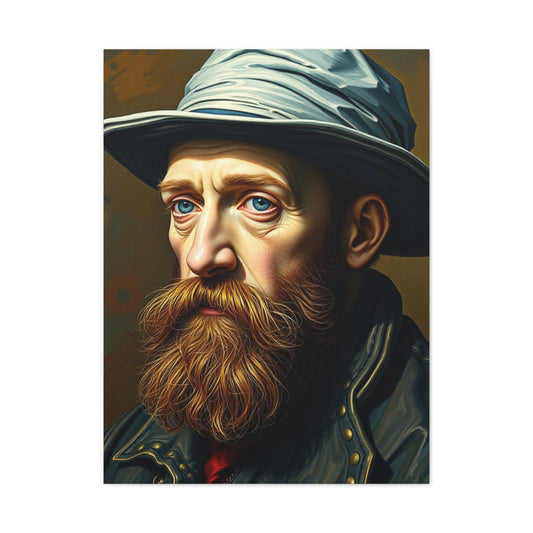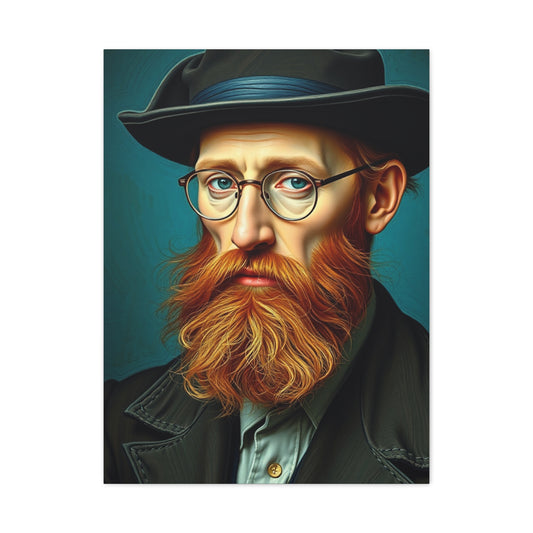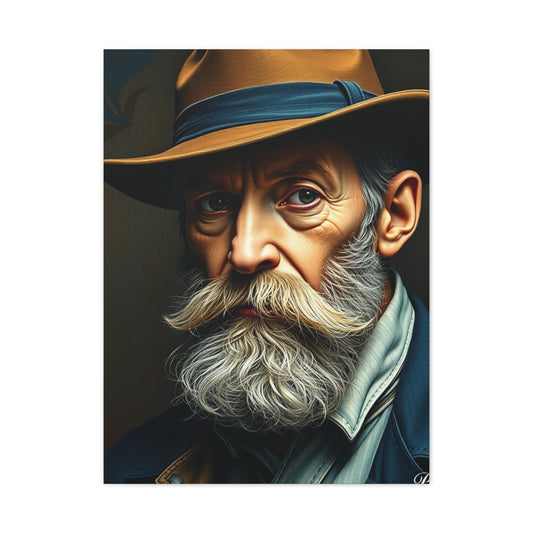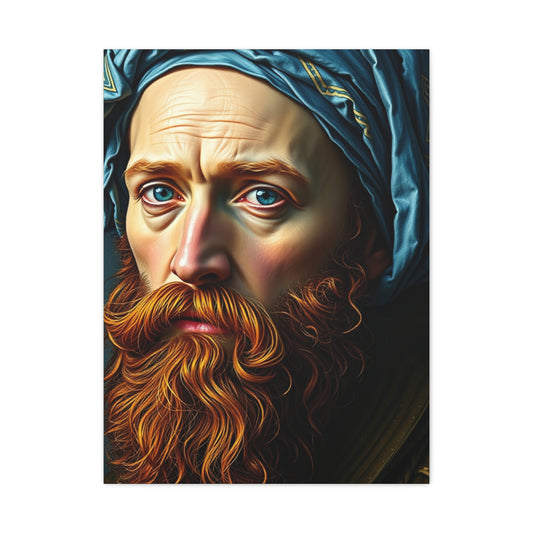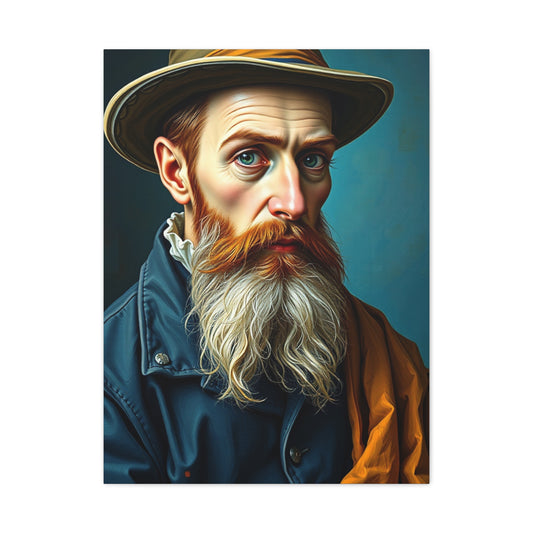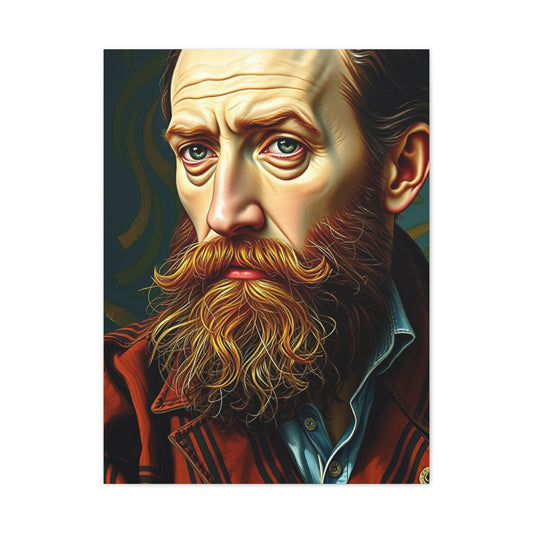Paul Cézanne's Art: Transform Your Space with Masterful Wall Decor
The revolutionary works of Paul Cézanne continue to captivate art enthusiasts and interior designers alike, offering an extraordinary opportunity to transform any living space into a sophisticated gallery. Known for his innovative approach to color, form, and composition, Paul Cézanne's masterpieces bring depth, character, and intellectual stimulation to contemporary homes and offices. His unique artistic vision bridges the gap between traditional impressionism and modern abstract expressionism, making his works perfect for today's discerning collectors who seek both aesthetic beauty and cultural significance in their wall decor choices.
When considering wall art that stands the test of time, few artists command the respect and admiration that Cézanne does. His paintings offer viewers a glimpse into the mind of a revolutionary artist who challenged conventional artistic norms while creating visually stunning compositions that continue to inspire generations of artists and art lovers. The careful selection and placement of Cézanne-inspired wall art can dramatically enhance the ambiance of any room, creating focal points that spark conversation and reflection.
The enduring appeal of Paul Cézanne's work lies in its perfect balance of innovation and accessibility. While his paintings demonstrate sophisticated artistic concepts, they remain visually appealing to viewers regardless of their art background. This universal appeal makes Paul Cézanne's art an excellent choice for wall decor in both residential and commercial settings, where diverse audiences will appreciate the aesthetic and cultural value these pieces bring to the space.
Paul Cézanne's Art: Wall Worthy Masterpieces for Every Home
Paul Paul Cézanne's artistic legacy encompasses a remarkable range of subjects and styles that translate beautifully into wall art for modern homes. His paintings demonstrate an extraordinary ability to capture the essence of his subjects while pushing the boundaries of traditional artistic representation. From intimate still life compositions to sweeping landscape vistas, Paul Cézanne's work offers something for every taste and interior design preference.
The wall-worthy nature of Paul Cézanne's art stems from his masterful use of compositional elements that draw viewers into the painting while complementing the surrounding environment. His careful attention to balance, proportion, and visual weight makes his works ideal for creating harmonious interior spaces. Whether displayed as a single statement piece or as part of a curated collection, Paul Cézanne's paintings possess the visual strength and emotional resonance needed to anchor and elevate any room's design scheme.
Paul Cézanne's approach to painting involved meticulous observation and analysis of his subjects, resulting in works that reveal new details and meanings with each viewing. This quality makes his art particularly suitable for wall display, as viewers can continually discover fresh aspects of the composition, ensuring that the artwork remains engaging and relevant over time. The layered complexity of his paintings provides ongoing visual interest that prevents the familiar boredom often associated with decorative wall art.
The versatility of Paul Cézanne's artistic output means that collectors can find pieces appropriate for various room types and design aesthetics. His quieter, more contemplative works suit bedrooms and study areas, while his more vibrant and energetic paintings work wonderfully in living rooms, dining areas, and social spaces. This adaptability makes Paul Cézanne's art an excellent investment for those looking to create cohesive interior design schemes that incorporate meaningful artistic elements.
Modern reproduction methods have made high-quality Cézanne prints accessible to a broader audience, allowing art enthusiasts to enjoy museum-quality representations of his most famous works in their own homes. These reproductions maintain the essential visual characteristics that make Paul Cézanne's originals so compelling, including his distinctive color palette, brushwork texture, and compositional structure. When properly framed and displayed, these pieces can create the same visual impact and emotional response as viewing the originals in a gallery setting.
The investment value of Cézanne-inspired wall art extends beyond mere decoration to encompass cultural education and personal enrichment. Living with reproductions of his masterpieces provides daily exposure to some of the most significant artistic achievements in Western art history, fostering appreciation for artistic excellence and creative innovation. This educational aspect adds depth and meaning to the decorative function of wall art, creating a more intellectually stimulating living environment.
Bold Colors, Bold Walls: Embracing Paul Cézanne's Vibrant Palette
Paul Cézanne's revolutionary use of color transformed the art world and continues to inspire interior designers seeking to create bold, dynamic wall displays. His innovative approach to color relationships and harmony offers valuable insights for those looking to incorporate vibrant artistic elements into their living spaces without overwhelming the overall design scheme. The artist's ability to balance intense colors with subtle tonal variations creates paintings that are both visually striking and harmoniously integrated.
The bold color choices that characterize many of Paul Cézanne's works stem from his deep understanding of color theory and his willingness to experiment with unconventional combinations. Rather than simply copying the colors he observed in nature, Cézanne interpreted and enhanced them to create more emotionally resonant and visually powerful compositions. This approach resulted in paintings that maintain their visual impact regardless of changing interior design trends, making them excellent long-term investments for wall decor.
When incorporating Paul Cézanne's bold color palette into wall displays, it's essential to consider how these vibrant hues will interact with existing room elements such as furniture, textiles, and architectural features. His paintings often feature rich blues, warm oranges, deep greens, and earthy reds that can either complement or contrast with interior color schemes, depending on the desired effect. The key lies in understanding how Cézanne balanced these intense colors within his compositions and applying similar principles to room design.
The psychological impact of Paul Cézanne's bold colors cannot be understated when considering wall art selections. His use of warm tones creates feelings of comfort and energy, while his cooler palette choices evoke calm and contemplation. This emotional dimension of color makes his works particularly effective for creating specific moods within different living spaces, allowing homeowners to use art as a tool for enhancing the functional and emotional aspects of their environments.
Paul Cézanne's approach to color application, characterized by visible brushstrokes and layered pigment, adds textural interest that enhances the visual appeal of wall displays. This technique creates paintings that appear to change subtly under different lighting conditions, providing dynamic visual interest throughout the day. The interplay between color and texture in his works ensures that they remain visually engaging from various viewing distances and angles.
The durability of Paul Cézanne's color choices, both in terms of aesthetic appeal and physical longevity, makes his works ideal for permanent wall installations. His careful selection of pigments and application methods resulted in paintings that have maintained their vibrancy over more than a century, suggesting that high-quality reproductions will similarly retain their visual impact over time. This longevity factor is crucial for those investing in significant wall art pieces intended to serve as long-term design elements.
Modern printing and reproduction methods have advanced to the point where the subtle color relationships and textures that define Paul Cézanne's work can be accurately captured and presented on contemporary wall displays. These technical improvements mean that art enthusiasts can enjoy the full impact of his bold color palette in their own homes, creating interior environments that rival professional gallery spaces in terms of visual sophistication and cultural significance.
Paul Cézanne's Still Life Magic: Bringing Everyday Objects to Life
The still life paintings of Paul Cézanne represent some of the most profound and influential works in art history, transforming simple everyday objects into complex meditations on form, color, and spatial relationships. His approach to still life composition offers valuable lessons for those seeking to understand how carefully arranged elements can create powerful visual narratives suitable for sophisticated wall displays. The magic of Paul Cézanne's still life works lies in his ability to imbue ordinary subjects with extraordinary significance and beauty.
Paul Cézanne's still life compositions typically featured common household items such as apples, pears, bottles, and fabric drapery, yet his treatment of these subjects elevated them to the level of high art. His careful arrangement of objects created dynamic relationships between forms, colors, and textures that continue to fascinate viewers more than a century after their creation. This transformation of the mundane into the magnificent makes his still life works particularly appealing for home wall displays, where they can inspire similar appreciation for the beauty inherent in everyday life.
The compositional sophistication of Paul Cézanne's still life paintings demonstrates his mastery of visual organization and spatial relationships. He carefully considered the placement of each element within the picture plane, creating balanced yet dynamic arrangements that guide the viewer's eye through the composition in deliberate patterns. This attention to compositional structure makes his still life works excellent choices for wall displays, as they provide clear focal points while maintaining visual harmony with surrounding design elements.
The intimate scale of many of Paul Cézanne's still life paintings makes them particularly suitable for smaller wall spaces or as part of grouped displays. Unlike his larger landscape works, these paintings can work effectively in bedrooms, studies, or dining areas where their quiet contemplative nature enhances the room's function. The personal, almost meditative quality of his still life subjects creates an atmosphere of calm reflection that many homeowners find appealing in private living spaces.
Paul Cézanne's innovative approach to perspective and spatial representation in his still life works challenged traditional artistic conventions while creating visually compelling compositions. His willingness to distort conventional perspective in service of artistic expression resulted in paintings that appear both familiar and surprising, offering viewers fresh insights into common subjects. This element of visual surprise helps maintain long-term interest in wall displays featuring his still life works.
The color relationships within Paul Cézanne's still life paintings offer masterful examples of how different hues can work together to create harmonious yet dynamic compositions. His ability to find unexpected color connections between disparate objects provides valuable inspiration for interior designers seeking to create cohesive color schemes that incorporate bold artistic elements. The subtle color variations within individual objects demonstrate his sophisticated understanding of how light and shadow affect color perception.
The texural qualities of Paul Cézanne's still life paintings, achieved through his distinctive brushwork and paint application methods, add dimensional interest that enhances their suitability for wall display. The visible brushstrokes and layered paint create surfaces that appear to change under different lighting conditions, ensuring that these works continue to reveal new aspects of their construction and meaning over time. This dynamic quality prevents the static feel that can develop with some forms of wall art.
Modern Walls, Classic Cézanne: Bridging Past and Present
The integration of classic Cézanne artwork into contemporary interior design represents a sophisticated approach to creating living spaces that honor artistic tradition while embracing modern aesthetics. His paintings possess a timeless quality that transcends specific decorating trends, making them excellent anchor pieces for evolving design schemes. The challenge lies in successfully balancing the historical significance and classical beauty of his works with the clean lines and minimalist sensibilities that characterize much of contemporary interior design.
Modern wall display methods offer exciting opportunities to present Paul Cézanne's works in fresh, innovative ways that enhance both the artwork and the surrounding environment. Contemporary framing options, lighting systems, and mounting techniques can dramatically improve the viewing experience while ensuring that the essential character of the paintings remains intact. The key is selecting presentation methods that complement rather than compete with the artistic content.
The neutral backgrounds and simplified compositions favored in modern interior design actually enhance the visual impact of Paul Cézanne's complex, richly detailed paintings. When surrounded by clean architectural lines and uncluttered spaces, his works become more prominent focal points that command attention and admiration. This contrast between simple contemporary design elements and complex classical artwork creates dynamic visual tension that energizes living spaces.
The scale considerations involved in displaying Paul Cézanne's works within modern architectural contexts require careful planning to achieve optimal visual impact. Contemporary homes often feature larger wall surfaces and more generous ceiling heights than the domestic spaces for which many of his paintings were originally intended. This presents opportunities to create dramatic gallery-style displays that showcase individual works or curated collections with museum-quality presentation standards.
Color coordination between Paul Cézanne's palette and modern interior design schemes requires understanding both the historical context of his color choices and the contemporary meaning of specific hues. His earthy tones and natural color relationships work particularly well with modern design trends toward sustainable materials and biophilic design principles. The organic quality of his color palette provides warmth and humanity that can soften the sometimes sterile appearance of ultra-modern interiors.
The philosophical alignment between Paul Cézanne's artistic principles and modern design aesthetics creates natural harmony when his works are properly integrated into contemporary spaces. Both emphasize essential forms, honest materials, and functional beauty over superficial decoration. This shared emphasis on authenticity and substance makes Paul Cézanne's art particularly suitable for modern interiors that prioritize quality and meaning over fashionable trends.
Lighting considerations for displaying Paul Cézanne's works in modern settings require balancing preservation concerns with optimal viewing conditions. Contemporary LED lighting systems offer precise control over both intensity and color temperature, allowing for ideal presentation conditions that bring out the full beauty of his complex color relationships and textural effects. Proper lighting can transform a simple wall display into a dramatic artistic statement that rivals professional gallery presentations.
Paul Cézanne's Landscapes Shine: Natural Beauty for Interior Spaces
The landscape paintings of Paul Cézanne represent some of his most beloved and influential works, offering viewers access to his unique vision of the natural world through compositions that balance observational accuracy with artistic interpretation. His landscapes demonstrate an extraordinary ability to capture the essential character of specific locations while transcending mere topographical representation to achieve universal significance. These qualities make his landscape works particularly effective for interior wall displays, where they can bring the beauty and tranquility of nature into urban living environments.
Paul Cézanne's approach to landscape painting involved intensive observation and analysis of natural forms, resulting in compositions that reveal the underlying structure and harmony present in natural environments. His ability to simplify complex natural scenes into comprehensible visual arrangements makes his landscapes excellent choices for wall art, as they provide viewers with accessible entry points into both artistic appreciation and natural beauty. The clarity of his compositional organization ensures that his landscapes work effectively as focal points within interior design schemes.
The seasonal variations captured in Paul Cézanne's landscape paintings offer opportunities to create rotating wall displays that reflect changing natural cycles and personal preferences. His depictions of spring blossoms, summer foliage, autumn colors, and winter structures provide a complete range of natural moods and atmospheres suitable for different times of year and varying decorative needs. This seasonal adaptability makes collections of his landscape works valuable long-term investments for interior design.
The geographic diversity of Paul Cézanne's landscape subjects, ranging from the familiar countryside of Provence to more exotic Mediterranean locations, provides options for creating wall displays that reflect personal travel experiences or aspirational destinations. His paintings can serve as visual reminders of favorite places or as inspiration for future journeys, adding personal meaning to their decorative function. This connection between artwork and personal experience enhances the emotional resonance of interior spaces.
The scale variations in Paul Cézanne's landscape works accommodate different wall sizes and viewing distances, from intimate studies suitable for small spaces to grand compositions designed for prominent display areas. His smaller landscape sketches work effectively in private spaces like bedrooms or studies, while his larger, more complex compositions command attention in living rooms, lobbies, or other public areas. This range of options allows for flexible interior design planning.
The color harmony present in Paul Cézanne's landscapes provides valuable guidance for creating cohesive interior color schemes that incorporate natural elements. His sophisticated understanding of how colors interact in natural settings offers insights into creating artificial lighting and decorative elements that complement rather than compete with natural color relationships. The organic quality of his palette ensures compatibility with a wide range of interior design styles and color preferences.
The emotional impact of Paul Cézanne's landscapes extends beyond mere visual appeal to encompass psychological and spiritual dimensions that enhance the quality of interior environments. His ability to capture the essential spirit of natural places creates artwork that can provide daily inspiration, stress relief, and connection to the natural world even in highly urbanized settings. This therapeutic aspect of his landscapes makes them particularly valuable for residential and workplace environments.
Geometry Meets Art: Understanding Paul Cézanne's Structural Innovation
Paul Paul Cézanne's revolutionary approach to artistic composition involved a sophisticated understanding of geometric principles that transformed traditional painting methods and continues to influence contemporary art and design. His famous advice to "treat nature by means of the cylinder, the sphere, the cone" reflects a fundamental shift toward seeing natural forms in terms of their underlying geometric structure rather than surface appearances alone. This geometric foundation makes his works particularly compatible with modern interior design principles that emphasize clean lines, balanced proportions, and structural clarity.
The geometric analysis that underlies Paul Cézanne's compositions creates paintings with strong architectural qualities that complement contemporary interior spaces. His careful attention to the relationship between different shapes and forms within his compositions demonstrates principles of visual organization that parallel those used in successful interior design. The structural integrity of his paintings makes them excellent anchor pieces for rooms where geometric clarity and visual balance are important design considerations.
Paul Cézanne's innovative use of geometric perspective challenged traditional single-point perspective systems while creating more dynamic and visually interesting compositions. His willingness to show objects from multiple viewpoints simultaneously resulted in paintings that appear both familiar and surprising, offering viewers new insights into common subjects. This element of visual complexity ensures that his works continue to reward careful observation and contemplation over time.
The mathematical precision underlying Paul Cézanne's color relationships demonstrates his understanding of how geometric principles apply to color theory as well as form. His systematic exploration of complementary colors, temperature relationships, and value contrasts creates harmonious yet dynamic color combinations that work effectively in interior settings. The predictability of his color logic makes it easier to coordinate his paintings with existing interior color schemes.
The modular quality of many Cézanne compositions, where individual elements maintain their distinct identity while contributing to the overall unity, provides valuable insights for creating wall displays that combine multiple artworks or integrate art with other decorative elements. His understanding of how individual components can work together to create larger wholes offers guidance for curating gallery walls or room-spanning artistic installations.
The influence of Paul Cézanne's geometric innovations on subsequent artistic movements, including cubism and abstract art, demonstrates the forward-thinking nature of his artistic vision. Collectors who choose his works for wall display are investing in pieces that represent pivotal moments in art history while remaining visually relevant to contemporary aesthetic sensibilities. This historical significance adds intellectual depth to the decorative function of his paintings.
The technical aspects of Paul Cézanne's geometric approach, including his systematic brushwork patterns and careful color placement, create surface textures that enhance the visual interest of his paintings when viewed at close range. This attention to technical detail ensures that his works continue to reveal new aspects of their construction and meaning upon repeated viewing, making them excellent choices for intimate living spaces where they will be observed regularly.
Timeless Cézanne Prints: Investment in Artistic Heritage
The enduring popularity of Paul Paul Cézanne's artwork has led to the development of sophisticated reproduction methods that allow art enthusiasts to enjoy high-quality versions of his masterpieces in their own homes. These prints represent more than mere decoration; they constitute investments in cultural heritage that bring the beauty and significance of museum-quality art into everyday living environments. The careful production of Cézanne prints ensures that the essential visual characteristics that make his originals so compelling are preserved and presented with maximum fidelity.
The selection of appropriate Cézanne prints for wall display requires understanding the different reproduction methods available and their respective advantages for long-term display. Modern digital printing techniques can capture the subtle color relationships and textural qualities that define his work, while traditional lithographic processes may better preserve the handmade quality that characterizes his artistic approach. The choice between different reproduction methods depends on factors including budget, intended display location, and personal preferences regarding authenticity and artistic fidelity.
The framing and presentation of Cézanne prints significantly impact their visual effectiveness and longevity as wall art. Professional-quality frames not only protect the artwork from environmental damage but also enhance its visual presence within interior spaces. The selection of appropriate matting, glazing, and frame styles requires balancing preservation concerns with aesthetic considerations to create displays that honor both the artwork and the surrounding environment.
The educational value of living with high-quality Cézanne prints extends beyond mere aesthetic pleasure to encompass ongoing learning about art history, artistic techniques, and cultural heritage. Daily exposure to reproductions of his masterpieces provides opportunities for developing deeper appreciation of artistic excellence while fostering understanding of the historical and cultural contexts that shaped his work. This educational dimension adds intellectual value to the decorative function of wall art.
The market for Cézanne prints encompasses a wide range of quality levels and price points, making his work accessible to collectors with varying budgets and collecting goals. Limited edition prints and artist-supervised reproductions command higher prices but offer greater investment potential and cultural prestige, while more affordable commercial prints provide access to his imagery for those primarily interested in decorative applications. Understanding these market distinctions helps collectors make informed purchasing decisions.
The conservation requirements for Cézanne prints vary depending on the reproduction method, paper quality, and display conditions, but generally involve protecting the artwork from direct sunlight, excessive humidity, and physical damage. Proper conservation practices ensure that prints maintain their visual quality and investment value over time, making them suitable for long-term display in residential and commercial settings. The relatively modest conservation requirements of high-quality prints make them practical choices for most interior applications.
The versatility of Cézanne prints in terms of size, subject matter, and presentation options allows collectors to create customized wall displays that reflect personal preferences while maintaining artistic coherence. The availability of his works in various scales and formats enables the creation of comprehensive collections that can evolve over time as living situations and decorative preferences change. This flexibility makes Cézanne prints excellent foundation pieces for developing artistic collections.
Paul Cézanne's Brushstroke Beauty: Texture and Movement in Wall Art
The distinctive brushwork that characterizes Paul Paul Cézanne's paintings represents one of his most significant contributions to artistic development, creating visual textures that add dimensional interest to wall displays while demonstrating his innovative approach to paint application. His brushstrokes serve both descriptive and expressive functions, simultaneously describing the forms of his subjects and conveying emotional responses to them. This dual purpose makes his paintings particularly engaging as wall art, as viewers can appreciate both the technical skill and emotional content expressed through his brushwork.
Paul Cézanne's systematic approach to brushwork, characterized by parallel strokes that follow the contours of forms, creates surface patterns that enhance the structural clarity of his compositions while adding visual interest through textural variation. This methodical paint application results in surfaces that appear to vibrate with energy and life, creating dynamic visual effects that change subtly under different lighting conditions. The consistent quality of his brushwork ensures that this textural interest remains engaging over time rather than becoming visually distracting.
The directional quality of Paul Cézanne's brushstrokes serves compositional functions by guiding viewers' eyes through his paintings in deliberate patterns that enhance understanding of spatial relationships and visual hierarchy. His strategic use of brushstroke direction creates implied movement and energy that brings static subjects to life, making his paintings particularly effective as focal points in interior spaces. This sense of movement prevents his works from appearing static or decorative, maintaining their artistic integrity as serious creative expressions.
The color modulation achieved through Paul Cézanne's layered brushwork creates sophisticated color relationships that demonstrate his advanced understanding of how different hues interact when placed in close proximity. His technique of applying pure colors in separate brushstrokes that optically mix when viewed from appropriate distances creates more vibrant and luminous color effects than conventional blending methods. This optical color mixing ensures that his paintings maintain their visual impact under various viewing conditions and lighting situations.
The scale relationships between individual brushstrokes and overall composition sizes in Paul Cézanne's works create optimal viewing distances that enhance the effectiveness of wall displays. His paintings are designed to be viewed from distances where individual brushstrokes merge into coherent forms while remaining visible enough to create textural interest. Understanding these optimal viewing distances helps in planning wall displays that maximize the visual impact of his works within interior spaces.
The preservation of brushwork quality in reproductions of Paul Cézanne's paintings requires sophisticated printing techniques that can capture both the color relationships and textural characteristics of his paint application. High-quality reproductions maintain the visual texture that makes his original brushwork so compelling, ensuring that prints can provide similar aesthetic experiences to viewing the originals. The success of these reproduction techniques makes quality Cézanne prints viable alternatives to original works for most interior display purposes.
The influence of Paul Cézanne's brushwork innovations on subsequent artistic developments demonstrates the forward-thinking nature of his technical approach and ensures the continued relevance of his work to contemporary aesthetic sensibilities. His influence on movements including fauvism, expressionism, and abstract art guarantees that his technical innovations remain important to understanding the development of modern art, adding intellectual depth to their decorative function in interior settings.
Art That Transforms Walls: Creating Atmospheric Environments
The transformative power of Paul Paul Cézanne's artwork extends far beyond simple decoration to encompass the creation of entire atmospheric environments that can fundamentally alter the character and mood of interior spaces. His paintings possess an extraordinary ability to establish emotional tone and cultural sophistication within rooms, making them powerful tools for interior design that goes beyond surface aesthetics to encompass psychological and spiritual dimensions. The careful selection and placement of Paul Cézanne's works can transform ordinary walls into windows that open onto new worlds of artistic beauty and intellectual stimulation.
The atmospheric qualities inherent in Paul Cézanne's paintings stem from his masterful manipulation of color, light, and spatial relationships to create convincing illusions of three-dimensional space and environmental conditions. His ability to capture the essential character of different times of day, seasonal variations, and weather conditions through paint alone demonstrates technical skills that translate beautifully to interior applications where creating specific moods and atmospheres is important. The subtlety of his atmospheric effects ensures that these environmental qualities enhance rather than overwhelm interior spaces.
The psychological impact of living with Paul Cézanne's art involves exposure to visual compositions that embody principles of harmony, balance, and sophisticated aesthetic judgment. His paintings serve as daily reminders of artistic excellence and creative achievement, inspiring viewers to appreciate beauty and seek quality in other aspects of their lives. This elevating influence makes his works particularly valuable for residential environments where personal development and cultural enrichment are important goals.
The scale considerations involved in using Paul Cézanne's art to transform walls require understanding how different painting sizes and subjects affect spatial perception and room dynamics. Larger works can dramatically alter the apparent size and character of rooms, while smaller pieces create intimate focal points that draw viewers into closer examination. The strategic selection of appropriate scales for specific wall areas and room functions maximizes the transformative potential of artistic displays.
The lighting requirements for effectively displaying Paul Cézanne's works as transformative wall elements involve both technical and aesthetic considerations that impact the overall success of interior design schemes. Proper lighting not only protects the artwork from damage but also ensures that viewers can fully appreciate the subtle color relationships and atmospheric qualities that make his paintings so compelling. The investment in quality lighting systems pays dividends in terms of enhanced aesthetic impact and artwork preservation.
The integration of Paul Cézanne's art into broader interior design concepts requires understanding how his artistic principles relate to contemporary design philosophies and lifestyle preferences. His emphasis on essential forms, authentic materials, and honest expression aligns well with modern trends toward sustainable design and meaningful consumption. This philosophical compatibility ensures that his works remain relevant and valuable components of evolving interior design schemes.
The long-term impact of incorporating Paul Cézanne's transformative art into living environments includes ongoing opportunities for aesthetic education, emotional enrichment, and intellectual stimulation that continue to provide value long after initial installation. Unlike purely decorative elements that may lose their appeal over time, his paintings continue to reveal new meanings and visual relationships that maintain their interest and significance. This sustained engagement makes them excellent investments for those seeking to create interior environments that grow in meaning and value over time.
Elevate Space with Cézanne
The professional presentation of Paul Paul Cézanne's artwork within residential and commercial spaces requires sophisticated understanding of display principles that maximize both aesthetic impact and preservation requirements while creating environments that rival museum-quality installations. Professional display strategies encompass technical considerations including lighting design, environmental control, and security measures, as well as aesthetic decisions regarding placement, grouping, and integration with architectural elements. The goal is creating displays that honor the artistic significance of the works while enhancing their decorative function within contemporary interior spaces.
The planning phase of professional Cézanne displays involves careful analysis of available wall spaces, existing architectural features, and intended room functions to determine optimal placement strategies that enhance both the artwork and the surrounding environment. This analysis considers factors including viewing angles, traffic patterns, natural light exposure, and proximity to heat sources or other environmental hazards that could affect artwork preservation. Professional planning ensures that displays achieve maximum visual impact while maintaining appropriate conservation standards.
The selection of appropriate works for professional displays requires understanding the relationship between different painting subjects, sizes, and color schemes to create coherent visual narratives that enhance rather than compete with each other. The curation of Cézanne displays involves balancing variety with unity, ensuring that individual works maintain their distinct identities while contributing to larger aesthetic goals. This curatorial approach creates displays that provide ongoing visual interest while maintaining professional presentation standards.
The technical aspects of professional Cézanne displays include sophisticated framing, matting, and glazing options that provide optimal protection while enhancing visual presentation. Professional-quality frames not only protect artworks from physical damage and environmental threats but also contribute to their aesthetic impact through careful selection of materials, profiles, and finishes that complement both the artwork and surrounding interior elements. The investment in quality framing systems pays dividends in terms of both preservation and presentation values.
The lighting design for professional Cézanne displays involves balancing conservation requirements with optimal viewing conditions to create presentations that bring out the full beauty of his complex color relationships and textural effects. Modern LED lighting systems offer precise control over both intensity and color temperature, allowing for ideal presentation conditions that can be adjusted throughout the day to accommodate changing natural light conditions. Professional lighting design ensures that displays maintain consistent quality under various viewing conditions.
The environmental control requirements for professional displays include monitoring and managing temperature, humidity, and air quality to ensure long-term preservation of artworks while maintaining comfortable viewing conditions. Professional display environments incorporate discrete monitoring systems that track environmental conditions and alert facility managers to potential problems before they can affect artwork condition. These systems ensure that displays maintain museum-quality preservation standards in residential or commercial settings.
The security considerations for professional Cézanne displays involve protecting valuable artworks from theft, vandalism, and accidental damage through appropriate hardware, monitoring systems, and access controls. Professional security systems are designed to provide comprehensive protection while remaining visually unobtrusive and compatible with aesthetic goals. The integration of security measures into display design ensures that protection requirements do not compromise the visual effectiveness of artistic presentations.
The maintenance requirements for professional displays include regular cleaning, condition monitoring, and preventive conservation measures that ensure artworks maintain their visual quality and investment value over time. Professional maintenance programs involve scheduled inspections, environmental monitoring, and conservation treatments as needed to address any deterioration before it becomes visually apparent or threatens artwork integrity. These maintenance programs ensure that displays continue to provide optimal aesthetic impact throughout their intended display periods.
The documentation requirements for professional displays include detailed records of artwork condition, display conditions, and maintenance activities that support insurance coverage and facilitate future conservation planning. Professional documentation systems provide comprehensive records that demonstrate proper care and handling, supporting both insurance claims and resale values for significant artworks. This documentation also facilitates planning for future display changes or conservation treatments.
The staff training requirements for professional displays include education about proper handling procedures, environmental monitoring, and emergency response protocols that ensure artwork safety while maintaining high-quality visitor experiences. Professional training programs ensure that all personnel understand their responsibilities for artwork protection while developing skills needed to assist viewers and maintain display quality. This training investment ensures that displays continue to meet professional standards throughout their operational periods.
Conclusion:
Paul Cézanne’s art remains a beacon of innovation, depth, and beauty—qualities that make his work an exceptional choice for transforming any living or working space into a sophisticated and inspiring environment. His revolutionary approach to form, color, and composition bridges the gap between traditional impressionism and the dawn of modern abstract art, offering a timeless aesthetic that continues to captivate contemporary audiences. By incorporating Cézanne-inspired wall decor, you invite not only visual appeal but also cultural and intellectual richness into your surroundings.
What sets Cézanne’s work apart is its ability to engage viewers on multiple levels. The layered complexity of his compositions reveals new details and insights with every glance, encouraging prolonged contemplation and repeated enjoyment. This enduring engagement is especially valuable in a home or office setting, where art can serve as a source of daily inspiration, reflection, and conversation. Whether it’s the serene still lifes, the majestic landscapes, or the striking portraits, each piece carries an emotional and visual resonance that anchors a room’s design while inviting viewers into a deeper artistic dialogue.
Moreover, Cézanne’s masterful use of color adds an extraordinary dimension to wall decor. His bold yet balanced palettes—ranging from vibrant blues and warm oranges to earthy greens and reds—offer endless possibilities for complementing or contrasting with your existing interior scheme. His nuanced understanding of color harmony allows his works to remain fresh and impactful regardless of changing design trends, ensuring that Cézanne-inspired pieces are not just decoration but lasting investments in aesthetic excellence.
The accessibility of high-quality reproductions has democratized the experience of owning Cézanne’s art, making it possible for collectors and enthusiasts of all levels to bring museum-worthy pieces into their personal spaces. These reproductions faithfully capture the textures, brushwork, and color vibrancy that define his originals, providing the same emotional and visual impact found in galleries around the world. When thoughtfully framed and displayed, these works transform ordinary walls into extraordinary galleries that reflect personal taste and artistic appreciation.
Finally, choosing Paul Cézanne’s art as wall decor elevates your space beyond mere aesthetics. It enriches it with a narrative of creative innovation and cultural heritage, turning your living environment into a place of beauty, intellect, and emotional connection. Cézanne’s masterpieces serve as timeless reminders that art has the power not only to decorate but also to inspire, transform, and connect us to the broader human experience.
In essence, embracing Paul Cézanne’s art in your interior design is an invitation to experience a masterful blend of tradition and modernity, color and form, intellect and emotion—creating spaces that are as visually stunning as they are deeply meaningful.


